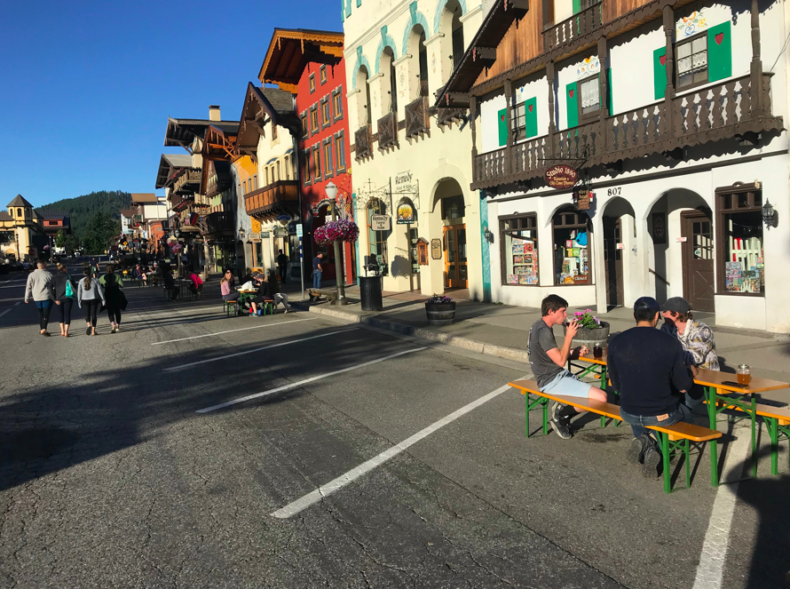
The kitschiest town in Washington nestles in the Cascades, two hours east of Seattle and three west of Spokane, where the Wenatchee River elbows its way through a cleft in snow-veined mountains. This is the picturesque home of Leavenworth, a faux-Bavarian town that has gone all-in on a year-round Oktoberfest vibe. The ersatz chalets boast angled roofs and baroque moldings, the beer gardens — sorry, biergartens — serve bratwurst, and lederhosen is de rigueur. Two thousand people allegedly live in Leavenworth, but it seems always to crawl with tourists, which, of course, is the point: The Bavarian theme was the brainchild of two Seattle-based diner owners who, in the 1960s, whipped up the ploy in hopes of transforming a decaying timber town into a recreational hub. In that endeavor, they succeeded, and then some. If a Christmas card were a physical location, it would be Leavenworth.
This all makes it sound like I’m disdainful, when in fact I think Leavenworth is good, clean, campy fun — who doesn’t love “The Sound of Music,” and besides, better an artificial culture than none at all. Mostly I admire how wholeheartedly it’s committed to the gimmick: Even, like, the local NAPA Auto Parts franchise writes its name in an ornate Ye Olde font.
So, when Elise and I found ourselves camped in the Cascades earlier this summer, I made a point of dragging us into town, motivated by morbid curiosity as well as nostalgia. Surely, I thought, Leavenworth would be lifeless — how could the consummate tourist town possibly thrive during modernity’s worst travel season? As it turns out, you can’t keep good American tourists down. From a distance, the streets seemed to be packed as ever with milling Seattleites, licking droopy ice cream cones and gulping Hefeweizens with unmasked mouths. As we walked toward the main drag, my wife and I exchanged dubious glances: Were we heading into an incipient hot zone?
Yet the town, we quickly realized, had been transformed, and decidedly for the better. To prevent the virus from brewing indoors, the schnitzelhauses and bakeries were only serving takeout, exiling their patrons to the streets. In turn, the town had placed picnic tables up and down the streets, with ample space between them, to facilitate outdoor dining. And to accomplish that, it had set up barricades at both ends of downtown, closing the urban core off to traffic altogether. Cars had been kicked out, and, in their absence, the town converted into a vast al fresco biergarten.
It was, of course, an infinitely more pleasant user experience. Where once the curb had been choked with legions of parked devil-wagons, now it was the domain of laughing couples and cheerful drinkers; where once pedestrians had to dodge cars weaving through cramped streets, now the boulevard felt open and airy. The shopping district felt less like a cheesy, manufactured cash-grab and more like an organic expression of civic life. It even felt, dare I say, authentic, or at least more so: less automotively and American, more walkably European. The town’s entire perspective had shifted dramatically — away from a chaotic, dangerous, and unpleasant vehicular orientation to a meandering, manageable human one.
Lately, this shift has been happening around the world. The pandemic has laid bare how much space we’ve surrendered to cars, and how little acreage we grant foot traffic. When you’ve been enjoined to stay six feet away from your fellow pedestrians, every sidewalk interaction becomes fraught with viral peril. “Things that might have only slightly rankled before—the couple insisting on running side by side down a narrow sidewalk, the dog walker thoughtlessly unspooling a long leash, the large family strolling four abreast—are now sources of real anxiety,” wrote Tom Vanderbilt in the Atlantic in April. By claiming the primest real estate for themselves and forcing flesh-and-blood humans into close quarters, cars operate in staunch opposition to social distancing. We are all marooned mariners in an automotive sea, clinging to tiny islands of sidewalk and green space as the tide of traffic rises around us.
Happily, our planet’s urban planners aren’t letting a crisis go to waste. In Milan, officials have announced plans to convert more than twenty miles of city streets to bike lanes; in Brussels, walkers and bikers will receive priority throughout the entire urban core. The most thrilling opportunities lie in New York, where new plans to liberate Manhattan from the tyranny of cars seem to arise daily. The city recently waived sidewalk cafe permits, which normally cost restaurateurs an arm and a leg, allowing outdoor dining to flourish and creating, in the process, magical culinary grottos. “(E)very block or so holds out the possibility of a quick getaway to a faraway beach or an elegant urban glade,” enthused the critic Pete Wells.
New York, of course, is relatively amenable to such dramatic shifts: It’s a famously dense city with readily accessible public transit and, at least compared to the rest of our car-enthralled country, a minuscule rate of vehicle ownership. A mountain town in the middle of nowhere would seem to be a less likely candidate for a pedestrian-friendly overhaul, yet Leavenworth has made itself over nonetheless. So let’s raise a stein to everyone’s favorite Bavarian getaway, and hope that Leavenworth’s car-free downtown outlasts the disease that inspired it.
A lovely post. As a European in the USA I miss those pedestrianised thoroughfares which bustle with merriment in the Summer heat. Let’s hope more towns and cities reflect on the opportunities they have been given and take steps to maintain these atmospheres.
Indeed! Thanks for your kind words, Ian — and there’s no doubt Europe is far, far ahead of the US on this issue (not to mention so many others).